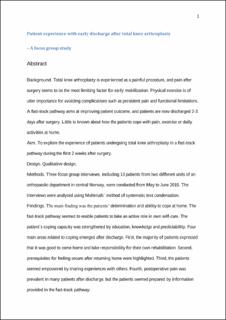| dc.contributor.author | Høvik, Lise Husby | |
| dc.contributor.author | Aglen, Bjørg | |
| dc.contributor.author | Schnell Husby, Vigdis | |
| dc.date.accessioned | 2020-09-28T07:50:54Z | |
| dc.date.available | 2020-09-28T07:50:54Z | |
| dc.date.created | 2017-09-22T14:53:49Z | |
| dc.date.issued | 2018 | |
| dc.identifier.citation | Scandinavian Journal of Caring Sciences. 2018, 32 (2), 833-842. | en_US |
| dc.identifier.issn | 0283-9318 | |
| dc.identifier.uri | https://hdl.handle.net/11250/2679843 | |
| dc.description.abstract | Background Total knee arthroplasty is experienced as a painful procedure, and pain after surgery seems to be the most limiting factor for early mobilisation. Physical exercise is of utter importance for avoiding complications such as persistent pain and functional limitations. A fast-track pathway aims at improving patient outcome, and patients are now discharged 2–3 days after surgery. Little is known about how the patients cope with pain, exercise or daily activities at home. Aim To explore the experience of patients undergoing total knee arthroplasty in a fast-track pathway during the first 2 weeks after surgery. Design Qualitative design. Methods Three focus group interviews, including 13 patients from two different units of an orthopaedic department in central Norway, were conducted from May to June 2015. The interviews were analysed using Malteruds` method of systematic text condensation. Findings The main finding was the patients' determination and ability to cope at home. The fast-track pathway seemed to enable patients to take an active role in own self-care. The patient's coping capacity was strengthened by education, knowledge and predictability. Four main areas related to coping emerged after discharge. First, the majority of patients expressed that it was good to come home and take responsibility for their own rehabilitation. Second, prerequisites for feeling secure after returning home were highlighted. Third, the patients seemed empowered by sharing experiences with others. Fourth, postoperative pain was prevalent in many patients after discharge, but the patients seemed prepared by information provided in the fast-track pathway. Conclusion The fast-track pathway released coping skills and resources among the patients. The expectation of, and preparation for early discharge made the patients feel confident when discharged few days after surgery. The patients expected to take great responsibility for their own rehabilitation process. | en_US |
| dc.language.iso | eng | en_US |
| dc.publisher | Wiley | en_US |
| dc.relation.uri | http://onlinelibrary.wiley.com/doi/10.1111/scs.12514/full | |
| dc.title | Patient experience with early discharge after total knee arthroplasty: a focus group study | en_US |
| dc.type | Peer reviewed | en_US |
| dc.type | Journal article | en_US |
| dc.description.version | acceptedVersion | en_US |
| dc.source.pagenumber | 833-842 | en_US |
| dc.source.volume | 32 | en_US |
| dc.source.journal | Scandinavian Journal of Caring Sciences | en_US |
| dc.source.issue | 2 | en_US |
| dc.identifier.doi | 10.1111/scs.12514 | |
| dc.identifier.cristin | 1497078 | |
| dc.description.localcode | This is the peer reviewed version of an article, which has been published in final form at [https://doi.org/10.1111/scs.12514]. This article may be used for non-commercial purposes in accordance with Wiley Terms and Conditions for Self-Archiving. " | en_US |
| cristin.ispublished | true | |
| cristin.fulltext | postprint | |
| cristin.qualitycode | 1 | |
